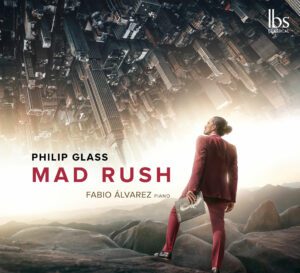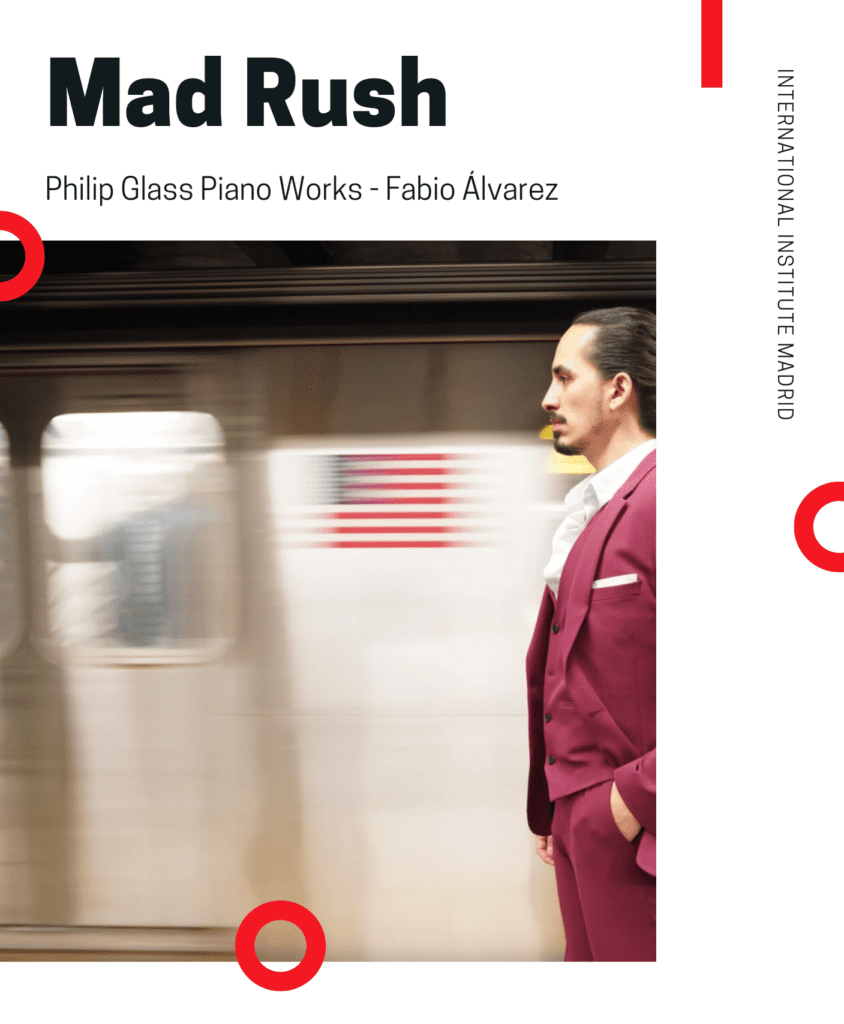
¿Por qué admira Fabio Álvarez a Philip Glass?
El 24 de marzo el Instituto Internacional presenta el pianista Fabio Álvarez en concierto, interpretando obras de Philip Glass. El concierto, Mad Rush: Philip Glass Piano Works – Fabio Álvarez, tendrá lugar en el histórico paraninfo del Instituto.
Este año el Instituto pone el foco en la música minimalista y la cultura estadounidense de finales del siglo XX. Con ocasión de la presentación en el Teatro Real de Nixon in China de John Adams en el mes de abril, el Instituto ha programado conciertos, cursos y eventos que a continuación detallamos.
En este próximo concierto, el pianista Fabio Álvarez interpretará una selección de obras para piano que cautivaron al propio Álvarez cuando vivía en Nueva York, estudiando en la Manhattan School of Music, donde obtuvo un Master of Music. Estas obras compuestas por Glass son el tema del último proyecto discográfico de Álvarez con IBS Classical, titulado también Mad Rush. El disco es candidato por Mejor Álbum de Clásica en los Premios de la Música Independiente este año. ¡Enhorabuena, Fabio!
Philip Glass, uno de los compositores más influyentes de la música minimalista estadounidense, acaba de cumplir 86 años el 31 de enero. Glass ha recibido innumerables premios a lo largo de las décadas. Recientemente, en 2022, fue galardonado en España con el XIV Premio Fundación BBVA Fronteras del Conocimiento por sus “extraordinarias aportaciones en los campos de la música y la ópera, que han tenido gran repercusión en la historia de la música de los siglos XX y XXI”.
Cuando Fabio Álvarez se trasladó de su hogar en Galicia a Nueva York para cursar allí sus estudios, encontró la música y el legado de Philip Glass ineludibles e inspiradores. Uno de los frutos de la experiencia de Álvarez en Nueva York es éste, su último proyecto discográfico, que estamos encantados de presentar al público en directo.
UNA ENTREVISTA CON FABIO ÁLVAREZ
Hemos preguntado a Fabio cómo llegó a interesarse por el minimalismo americano y por Philip Glass en particular.
Cuando te trasladaste por primera vez a Nueva York para cursar un máster, ¿sabías ya mucho sobre los compositores estadounidenses?
(FA) La verdad es que cuando llegué a Nueva York ya conocía bastantes compositores americanos gracias a mi maestro de piano contemporáneo en Grado en Musikene. Especialmente recuerdo:
- George Crumb: que más tarde se convertiría en el compositor al que dedicaría mi primer disco MUSICAL ZODIAC y con el que además tuve la oportunidad de conocer y trabajar su obra.
- John Adams: del cual interpreté su China Gates
- Steve Reich: del quién recuerdo una maravillosa audición de dos de mis compañeros que interpretaron su Piano Phase en dos pianos de cola.
- Henry Cowell: de quién interpreté su obra The Banshee.
Qué te atrajo de las composiciones de Philip Glass?
(FA) Es difícil de explicar con palabras, pero creo que lo que más me atrajo de su música es la sensación que su música producía en mí. Una música como él mismo dice de “estructuras repetidas”, pero con un número de repeticiones meditado y con una selección del material muy concreto para crear una sensación en el oyente.
Tuve las oportunidad de asistir al estreno de su ópera Akhnaten en el Metropolitan Opera, y fue absolutamente genial en todos los sentidos. Al salir de la ópera me dije “necesito grabar la música de Philip Glass”.
¿Hay algún otro compositor estadounidense que te guste mucho?
(FA) Sin duda mi otro compositor estadounidense sería George Crumb. Su obra muestra un mundo místico y maravilloso que me atrajo desde el primer momento que escuché su música. Invito a los lectores que escuchen sus dos primeros volúmenes de Makrokosmos: Twelve Fantasy Pieces After the Zodiac for Amplified Piano.
¿Cuáles son tus recuerdos más vivos de tu estancia en Nueva York?
(FA) Hay varios momentos que marcaron mi estancia en Nueva York, pero si tuviera que escoger quizá serían la graduación del Master of Music en la Manhattan School of Music, mi debut en Carnegie Hall en 2018, y el momento en que conocí por primera vez a la que hoy es mi mujer (a la cual está dedicada la última pieza del disco, una transcripción hecha por mí del Knee Play 5).

DESCRIPCIÓN DE LAS PIEZAS DE PHILIP GLASS
Mad Rush (1981) se escribió por primera vez como una pieza para órgano con ocasión de una visita a Nueva York del Dalai Lama (1935). Más tarde fue utilizado por la coreógrafa Lucinda Childs para un baile del mismo nombre. A diferencia del Witchita Vortex Sutra, que está completamente en fa mayor, Mad Rush oscila entre fa mayor y la menor en la forma de la música modal, donde el oyente no está seguro de cuál es el modo hasta el final. En este caso, fa mayor es el acorde “dominante”, y la menor es el “final”.
ETUDES
“Los Veinte Estudios Para Piano fueron compuestos durante los años 1991 a 2012. Su configuración final en el Libro 1 y el Libro 2 fue determinada por la música misma en el curso de su composición. El Libro 1 (Etudes 1-10) tenía un doble objetivo: explorar una variedad de tempi, texturas y técnicas de piano. Al mismo tiempo, estaba destinado a servir como una herramienta pedagógica con la que mejoraría mi forma de tocar el piano. De estas dos maneras, el Libro 1 tuvo mucho éxito. Aprendí mucho sobre el piano y en el curso de aprender música, me convertí en un mejor jugador. Surgieron nuevos proyectos e interrumpieron el trabajo en los Etudes durante varios años. Quizás por esa razón, cuando comencé a trabajar con los Etudes nuevamente, descubrí que la música estaba siguiendo un nuevo camino. Aunque resolví cuestiones de la técnica del piano para mí en el Libro 1, la música en el Libro 2 rápidamente comenzó a sugerir una serie de nuevas aventuras en armonía y estructura. De esta manera, los Libros 1 y 2, en conjunto, sugieren una trayectoria real que incluye una amplia gama de música e ideas técnicas. Al final, los Etudes están destinados a ser apreciados no solo por el oyente en general, sino especialmente por aquellos que tienen la capacidad y la paciencia de aprender, tocar y tocar la música ellos mismos.” (Philip Glass, 20 de octubre de 2014).
WICHITA VORTEX SUTRA
Wichita Vortex Sutra (1988) toma su título del poema escrito por Allen Ginsberg in 1966. Wichita Vortex Sutra (1988) es un acompañamiento inquietante y elegante para el poema de Allen Ginsberg sobre la Guerra de Vietnam. Los dos amigos se encontraron en una librería en el East Village de Nueva York y decidieron colaborar. Glass escribió la música para reflejar la lectura del poema de Ginsberg. Las bellas armonías consonantes se yuxtaponen con las imágenes gráficas de la guerra para crear un trabajo desarmador.
TRILOGY SONATA
La Trilogy Sonata (2000) consiste en tres transcripciones para piano de la trilogía de óperas “retratos” de Philip Glass, Einstein on the Beach (1976), Satyagraha (1979) y Akhnaten (1983). Una trilogía o tríptico de retratos, con las figuras de Albert Einstein en Einstein on the Beach, de Mahatma Gandhi en Satyagraha –“verdadera fuerza” en sánscrito– y del faraón egipcio Akenatón en la ópera homónima (Akhnaten, en el inglés original) En ellas, Glass aborda las vidas de tres hombres (el hombre de Ciencia, el hombre de Religión, el hombre de Política) que, según su enfoque, cambiaron el mundo a través de sus vidas y sus obras, por medio “del poder de las ideas y no del poder de la fuerza”.
KNEE PLAY 5 from “Einstein on the Beach” (Reworked by Fabio Álvarez)
Knee Play 5 (Reworked by Fabio Álvarez) es un arreglo hecho por el propio Fabio Álvarez para pianista/narrador del último de los 5 intermezzos o “knee plays” de la ópera Einstein on the Beach (1976).
La ópera consta de nueve escenas conectadas de 20 minutos en cuatro actos separados por “Knee Plays”. Cinco “Knee Plays” enmarcan la estructura de la ópera y aparecen entre actos, al mismo tiempo que funcionan como escenas de apertura y cierre. Glass define un “Knee Play” como un interludio entre actos y como “la ‘rodilla’ que se refiere a la función de unión que realizan las rodillas anatómicas de los humanos”. Si bien los “Knee Plays” ayudaron a crear el tiempo necesario para cambiar el escenario de los siete sets, estos interludios también cumplieron una función musical. David Cunningham, un estudioso de Glass, escribe que la intermitencia de “Knee Plays” de Glass entre los cuatro actos de la ópera sirve como un “motivo constante en toda la obra”.
Más información y entradas: Mad Rush: Philip Glass Piano Works – Fabio Álvarez.





